A strong finish to 2016 from Australian and global share markets ensured that super funds delivered a healthy return for the year and a fifth consecutive positive annual return. The median growth fund returned 7.7% in 2016, and every fund in the growth category delivered a positive result. Returns ranged between 4.2% and 10.1%, with Catholic Super and Hostplus tied for top spot. Growth funds are those that have a 61 to 80% allocation to growth assets and are the ones in which most Australians are invested.
Chant West director, Warren Chant says: "Members should be very pleased with the 2016 result, which was achieved against a backdrop of unsettled global politics and a relatively weak economic environment. Super funds have actually had a very good run since the end of the GFC. There's only been one negative year in the past eight, and that was the small loss of 1.9% in 2011. Other than that it's all been positive, and the cumulative return over that eight year period now amounts to about 93%, or an average of 8.6% per annum. That's nearly 6.5% above the annual rate of inflation, so it's comfortably ahead of the typical long-term objective for these funds which is to beat inflation by 3 to 4% annually.
"Three of the key stories in 2016 were the shock 'Brexit' vote, the equally surprising Donald Trump election victory and the timing of the second US interest rate hike. All of these created uncertainty, but share markets again proved how resilient they can be. Investors chose to focus on the gradual improvement in the US economy and what that might mean for global growth, and as a result international shares returned 8.9% in hedged terms and 7.9% unhedged. Australian shares did even better, returning a healthy 11.8%.
"While shares are the main drivers of performance, the major funds are well diversified across other assets as well, and in 2016 all asset sectors delivered positive returns. Some did better than others, of course, and the better performing funds were generally those that had higher allocations to Australian shares, Australian listed property, unlisted property and infrastructure. Those that kept more of their defensive assets in bonds rather than cash would also have benefited."
Chart 1 shows the top 10 performing growth options over the year, all of which are non-profit funds.
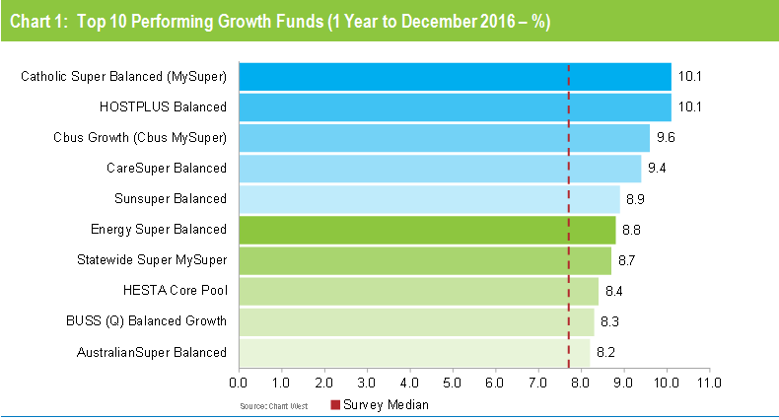
Notes:
1. The top 10 is limited to growth options with assets of $1 billion or more.
2. Performance is shown net of investment fees and tax.It is before administration fees and adviser commissions.
Table 1 compares the median performance for each fund category in Chant West’s Multi-Manager Survey, ranging from All Growth to Conservative. Over one, three, five and seven years, all risk categories have met their typical long-term return objectives, which range from CPI + 2% for Conservative funds to CPI + 5% for All Growth. However, the GFC continues to weigh down the ten year returns. Over ten years the higher risk categories failed to achieve their objectives, but Balanced and Conservative did. Over 15 years, only the All Growth category fell short of its objective having been hardest hit during the GFC.
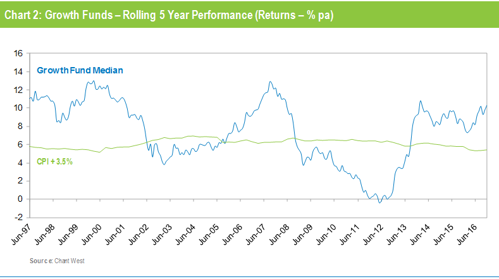
Source: Chant West
Note: Performance is shown net of investment fees and tax. It is before administration fees and adviser commissions.
Funds still delivering on risk and return targets
As well as acknowledging the solid one year returns, Chant encourages members to think long term. "With the growing importance of retirement income streams within super, most people will have money in the super system long after they retire. By all means look at what your fund delivered in 2016, but what’s really important is to know what its long-term objectives are and whether it’s achieving them.
"Funds themselves think long term and typically the return objective for growth funds is to beat inflation by 3% to 4% per annum over rolling five year periods. We now have data going back 24½ years to July 1992, which is when compulsory super was introduced. When we look back over that very long period, we find that the annualised return is 8.2% and the annual CPI increase is 2.5%, so the real return above inflation has averaged 5.7% per annum. So over the longest period we can measure funds have well and truly met their return objective.
"That’s borne out visually in Chart 2, which compares the growth category median with the average return objective for funds in that category (CPI plus 3.5% per annum after investment fees and tax over rolling five year periods).
"Before the GFC, the median fund had outperformed the target most of the time, but once the GFC years fed into the equation the return dipped below the target line for several years. Now, with the GFC period out of the calculation, the five year return has been tracking above the target line for nearly three years.
"Returns are important but so is risk, and most funds also set themselves a risk objective. Typically, for a growth fund, this is to post a negative return no more often than once in every five years on average. Chart 3 plots the year by year performance of the median growth fund over the full 24 calendar years since the introduction of compulsory super. In that time, there have been four years when returns were negative. That averages out to one year in six, so the risk objective has also been met.
"So the message is that over the longest period we can measure Australia’s major super funds have delivered for their members what they set out to do."
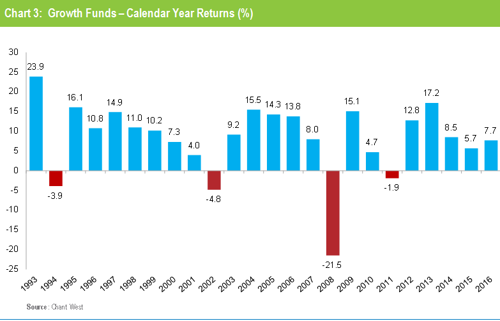
Note: The CPI figure for the December 2016 quarter is an estimate.

Note: Performance is shown net of investment fees and tax. It does not include administration fees or adviser commissions.
The investments that drove the performance
While there are differences between funds' investment strategies, even within the same risk category, most of their performance is driven by what happens in the major investment markets. For growth funds, that is primarily the Australian and international share markets, because those are the sectors where they allocate most of their money.
Table 2 shows the performance of all the main asset sectors over different time periods. We have used market indices for all sectors other than private equity and unlisted infrastructure. For those sectors, for which no indices exist, we have used the returns of a major fund in our survey that are representative of those markets.

Source: Chant West
The key points to note for the 2016 calendar year are:
- Australian shares performed strongly with a return of 11.8%
- Hedged international shares were up 8.9%.However, the appreciation of the Australian dollar against the British Pound and Euro reduced this to 7.9% in unhedged terms.
- Of the traditional sectors, Australian listed property was the best performer with a return of 13.2%.Unlisted Australian and global listed property produced returns of 11.1% and 6%, respectively.
- Infrastructure performed particularly well, with unlisted infrastructure generating 17.3% and global listed infrastructure 12.7%.Private equity produced a more modest return of 7.8%.
- Defensive asset sectors yielded the lowest returns but were still in the black. Australian and international bonds gained 2.9% and 5.2%, respectively, while the return from cash was just 2.1%.
Industry funds ahead of retail funds over the year and longer term
Industry funds outperformed retail funds over the year, returning 8.2% versus 6.9%. Industry funds also hold the advantage over the longer term, having returned 5.5% per annum against 4.6% for retail funds over the 10 years to December 2016, as shown in Table 3.

Source: Chant West
Note: Performance is shown net of investment fees and tax. It is before administration fees and adviser commissions.
Chart 4 compares the performance of the two segments year by year over the past ten years.
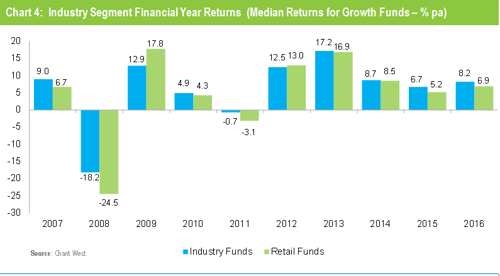
Chant says: "Over the longer term, industry funds have outperformed retail funds largely because, as a group, they tended to have lower allocations to listed shares during periods when shares underperformed. That situation no longer applies, but at the same time they have also had higher allocations to unlisted assets such as private equity, unlisted property and unlisted infrastructure which have performed well for them. That difference does still apply, with industry funds currently investing 20% in these sectors against 5% for retail funds, and that goes some way to explaining their outperformance in 2016.
"Over the longer term, the asset allocation policies of industry funds have served them very well. Those allocations to unlisted assets do mean slightly higher investment costs, but those extra costs have been more than justified by the better performance and lower volatility.
"Industry funds have also been more prepared to shift away from their longer-term target asset allocations to take advantage of mispricing or to preserve capital. Overall, those medium-term shifts have had a positive effect on their performance."
Chart 5 shows the top 10 performing funds over ten years. As has been the case for many years, the list is dominated by industry funds which account for eight of the ten places. The other two places are occupied by QSuper, which is a non-profit fund primarily for Queensland public servants, and the stand-alone fund for employees of Commonwealth Bank.
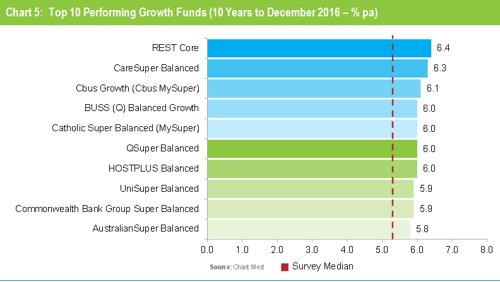
Notes:
1. The top 10 is limited to growth options with assets of $1 billion or more.
2. Performance is shown net of investment fees and tax. It is before administration fees and adviser commissions.






